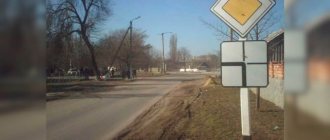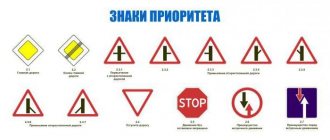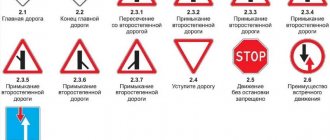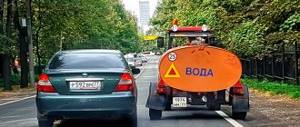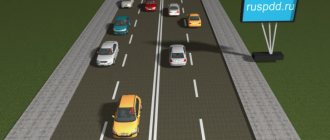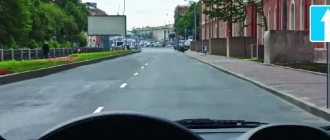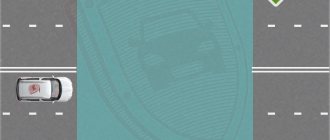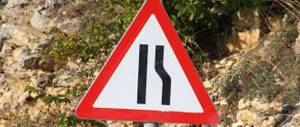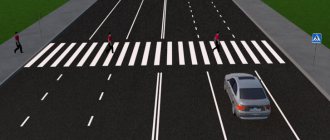Traffic rules terms and definitions
“Shoulder” is an element of the road adjacent directly to the roadway at the same level with it, differing in the type of surface or marked out using markings 1.2 (white solid line) used for driving, stopping and parking in accordance with the Rules.
“Obstacle” is a stationary object in the traffic lane (faulty or damaged vehicle, roadway defect, foreign objects, etc.) that does not allow further movement along this lane. A traffic jam or a vehicle stopped in this lane in accordance with the requirements of the Rules is not an obstacle.
“Main road” - a road marked with signs 2.1, 2.3.1 - 2.3.7 or 5.1, in relation to the one being crossed (adjacent), or a road with a hard surface (asphalt and cement concrete, stone materials, etc.) in relation to the dirt road , or any road in relation to exits from adjacent territories. The presence of a paved section on a minor road immediately before the intersection does not make it equal in importance to the one it intersects.
If I was driving along the main road, and in front of the intersection there is a sign for the end of the main road and a sign changing the direction of the main road (such a mistake, unfortunately) which shows that I am on a secondary road. What to do in this case? If the sign itself says that I am at the crossroads of equivalent roads?!
Also, a sign indicating a secondary road is “No driving without stopping”. In this case, you need to stop, make sure that there are no cars on the main road, and only then continue driving. By following the instructions of these signs, vehicles moving along the main road will be able to move freely.
In populated areas, the “Main Road” sign is duplicated because it does not have its own coverage area. That is, it indicates priorities only at the intersection in front of which it is located. But if the sign is placed after it, then its effect is established for the entire section of the road.
“Advantage (priority)” and “Give way (do not interfere)” are interrelated terms: if one already has an advantage, then the other must give way. It is only important that in any situation all road users accurately determine their status: who you are now - “first” or “second”.
It is quite possible that you have a question: “Why should you give in to someone on the right and not on the left?” This requirement of the Rules is nothing more than a consequence of right-hand traffic adopted in our country. Agree that your distance to the point of collision is greater than that of the driver of the gray car, that is, it is easier for you to comply with the “Give way” requirement. Tell me, will you now give way to a gray car? He's still on your right!
How to travel safely
In order not to provoke an accident when entering the main road, you need to make sure that there are no obstacles and realistically assess the capabilities of your car. According to general traffic rules, the driver must leave the road intersection immediately after exiting.
The car enthusiast must understand how much time he will spend to complete his maneuver. When driving onto the main road, you need to take into account a number of external factors:
- weather;
- quality of the road surface (crushed stone, sand, clay, etc.);
- extreme visibility;
- the presence of snow, ice or puddles on the road surface.
After entering the intersection, the driver must speed up his car so that other participants cannot catch up with him. You need to be extremely careful and not allow the vehicle to stop, since other motorists follow the rules and know about their advantage and may not slow down when approaching the intersection. As a result, there may simply not be enough time and distance for emergency braking.
Right turn
When leaving a secondary road on the main road, a motorist must follow the rules for crossing intersections, including unregulated ones. When turning right, he must take the extreme right position, make sure there are no obstacles: no one is approaching from the left and no one is making a U-turn from the oncoming lane. Only after this start moving. With such a maneuver, the car should be strictly in the rightmost lane in case of multi-lane traffic.
You need to start your maneuver only after you are sure of the intentions of other motorists.
For example, a person is moving in the right lane with the right turn signal on, having forgotten to turn it off at the previous intersection. Yes, on many cars it turns off on its own, but still. Another traffic participant intends to drive straight ahead with his turn signal on. Having started to move, leaving the additional roadway will provoke an emergency situation. In the event of an accident, it will be quite difficult to prove your case.
U-turn and left turn
When turning or making a U-turn, the driver needs to take the extreme left position closer to the center of the roadway. Next, make sure that no vehicles are approaching from either the left or the right. And only then begin to move to the dividing strip, as soon as you reach it, at this moment, and jump out to the left into your lane.
When making a turn, the driver is allowed to occupy any free lane. And then change to the required lane according to the road rules.
In the case of a U-turn, the driver must perform the same actions as when turning: drive to the median, enter the lane of passing traffic and turn back. If a motorist decides to turn around right at the edge of the roadway, he will grossly violate the road rules, as he will end up in oncoming traffic. This action is strictly prohibited, as it increases the risk of an emergency, even if no one is moving towards you.
Leaving the surrounding area
According to traffic rules, road users, when entering the main road from an adjacent one, are required to yield to others who have priority over them. This rule applies when traveling from adjacent areas: courtyards, gas stations, etc.
The rules clearly state that such areas are not intersections. However, the order and priority of travel follows the same principle: drivers on the main road have priority. Therefore, a motorist standing on an adjacent roadway is obliged to let others pass in all cases, regardless of the direction of travel.
Driving through intersections
Driving through uncontrolled intersections on a secondary road is regulated by a set of rules, clause 13.9. They determine priority for road users. Cars on the main road have priority. The remaining vehicles must wait until they complete their maneuver, and only then begin to perform theirs.
Trams have an advantage over cars and motorcycles when they are on an equivalent roadway.
Rules for driving through unregulated intersections
The advantage of the tram . A tram at an uncontrolled intersection has an advantage over trackless vehicles only when it moves along the main road or is on equal roads with them. If a tram approaches an intersection along a secondary road, then it gives way to trackless vehicles traveling on the main road.
If you cannot see the signs of regulation of the intersection from afar, then, if necessary, slow down and drive closer to the intersection. You see that the traffic light is not working, there is no traffic controller, and in your direction there is a sign 2.1 “Main Road”. This means that in front of you is an intersection of unequal roads, and you are moving along the main road.
Don't traffic rules apply here? An ordinary intersection
At first glance, everything is simple. The travel procedure is prescribed in paragraph 13.12 of the Rules. When turning left or making a U-turn, the driver of a trackless vehicle is required to give way to those moving straight or to the right on an equivalent road from the opposite direction.
But in our situation, both cars are moving on a secondary road. So what should we do? In the same way, because clause 13.12 of the traffic rules also applies in this case. Cars enter the intersection from equivalent roads. And if so, a green car turning left must give way to a white car, which is moving straight.
- When turning right, we give way to the vehicle on the left (blue car) and to oncoming traffic (green), if they are going in the same direction as us.
- When moving in a forward direction, it is necessary to give way to those on the left, to oncoming people, because they are driving on the main road, and also to the right (black car), although they are also on the secondary road, they are an “obstacle on the right.”
- When turning left, we also yield to everyone.
- Not the best option for a U-turn, but if there is no choice, we do it, yielding to all vehicles.
- When turning right, we do not give way to anyone.
- When moving straight, we also do not yield to anyone.
- When turning left and making a U-turn, we give way to oncoming vehicles (green car) moving in our direction (in this case, we reach the middle of the intersection and wait for them to pass), because they are also on the main road and are an obstacle for us on right. If oncoming people turn left, then we pass them in a friendly manner on the right side.
May 19, 2021 polrostov 68
Share this post
- Related Posts
- What to do if you lost your school travel card
- Driving school in St. Petersburg without bribes
- Life and Health Insurance Against Fracture
- Is the Balcony and Loggia Included in the Common Property?
What is a secondary road definition
For drivers who move in the direction designated as the main road, traffic rules require priority (primary) movement through uncontrolled intersections and intersections with secondary directions. Drivers traveling in a secondary direction are required to yield to traffic moving in the main direction. At controlled intersections, you should be guided by the signals given by the traffic controller or traffic light.
You may be interested in:: You can use your Moscow Social Card to travel around the Moscow region
Hello, please tell me what is the best thing to do in this situation. I leave the secondary road and turn left, and the oncoming car (number 3), which is also on the secondary road, also turns left. We pass each other, but what if there are others behind this car (number 3) who are going straight or to the left? In this situation, should I wait or should I simultaneously enter the intersection with the car (numbered 3) that is also turning left and let the cars behind it pass?
Turn left from a minor road
The main condition for a safe turn to the left from a secondary road is sufficient visibility of the road sections at the entrance to the intersection from all sides. Sufficient to allow the right decision to be made in a timely manner based on the existing road situation: continue driving or stop to yield.
Let's repeat it again. Vehicles traveling from both the left and right sides on the main road have an undeniable advantage in moving through the intersection (clause 13.9), and clause 13.12 also obliges to give way to oncoming vehicles that are moving towards, along a secondary road, in the direction "straight" or "to the right".
If a left turn from a secondary road occurs at a T-shaped intersection (when the secondary road adjoins the main road), then there is no oncoming road, and you will only have to yield to vehicles traveling on the main road.
In order to comply with the requirements of these points (give way) and not collide with other cars when turning left onto the main road, you need to assess the road situation at the approaches to the intersection. What “evaluate” means is explained in the article Turning right onto the main road and an accident.
In order to assess the situation at the intersection and its entrances, the dynamics of the situation, it must be seen.
Visibility, in turn, can be limited by various circumstances: various structures, road objects, vegetation, a bend or break in the road, large cars, etc.
If the visibility of an intersection does not provide a complete picture of what is happening at it, then you should drive onto the main road very carefully, looking carefully to both sides.
Essentially, when you are faced with the task of making a left turn onto a main road, the solution is not so much to comply with the requirement to “give way (not interfere)” with the participants who have the right of way, but to make the turn without getting hit in an accident.
If the main road turns at an intersection, e.g. changes direction, then turning from the secondary road to the left onto the main road, as a maneuver, is technically possible only in one case: when the main road “approaches” the intersection on the left.
If you approached such an intersection on a secondary road and intend to turn left onto the main road, then clause 13.9 of the traffic rules still obliges you to give way to driving vehicles on the main road, and clause 13.10 of the traffic rules still obliges you to give way to those approaching the intersection on the right, just like you along a secondary road.
An important feature of uncontrolled intersections is the capacity of the roads that form these intersections.
When there is a continuous flow of traffic on the main road of an intersection, a large number of vehicles may gather from secondary directions, especially during rush hours. Everyone, of course, will try to pass at the moments when “windows” for entering the intersection are formed.
In such conditions (if there are a lot of cars), when the opportunity to travel appears, all those suffering literally take off and drive into the main road in a double or even triple stream, whoever is faster, and then distribute themselves along the road.
With such crowds, accidents of varying degrees of “seriousness” often occur. Some of them, the most common, are discussed below in the text.
Traffic rules terms and definitions
“Safety island” is an element of the road arrangement that separates traffic lanes (including lanes for cyclists), as well as traffic lanes and tram tracks, structurally separated by a curb stone above the roadway or marked by technical means of traffic management and intended to stop pedestrians when crossing the roadway. The traffic island may include part of the dividing strip through which a pedestrian crossing is laid.
“Road” is a strip of land or a surface of an artificial structure equipped or adapted and used for the movement of vehicles. The road includes one or more carriageways, as well as tram tracks, sidewalks, shoulders and dividing strips, if any.
- 2.1 is placed at the beginning of the segment with priority right of movement through, as well as immediately before intersections.
- If at the intersection the main road changes direction, then in addition to 2.1, a sign 8.13 is installed.
- The end of the section where the driver was driving along the main road is indicated by sign 2.2.
- 2.3.1 informs about the approach to the intersection with directions of secondary importance simultaneously from the left and right.
- 2.3.2–2.3.7 – about approaching the junction on the right or left of a secondary road.
- The sign “Motorway” (5.1) indicates the main road to which the rules for traveling on motorways apply. 5.1 is placed at the beginning of the highway.
When constructing onshore transport and storage facilities for oil, petroleum products and gas, the road network at the construction site consists of main and secondary roads. Main highways are designed in areas with the most intense traffic; they must have a width of at least 6 m and provide two-way traffic flow, as well as bypass for vehicles standing under unloading. These roads are provided with widenings necessary for passing oncoming traffic and for ensuring the passage of vehicles during unloading in the crane's operating area. Main and secondary roads should not be designed as dead ends. As an exception, the construction of dead-end secondary roads is allowed with the obligatory organization of areas for turning vehicles.
To mark adjacent roads, signs are used in the form of white equilateral triangles, with a red border around the perimeter, with an image of the road situation in the center. They are installed on the main road to inform drivers about possible situations for making the desired maneuver.
I would be very grateful if you could comment on the rules for driving on a secondary road at an “offset” intersection. The situation is this: the main street (A) goes straight, two secondary streets (B and C) adjoin it at different levels. Apparently there is only one intersection (a cross-shaped one, not two T-shaped ones), since the main road signs are not duplicated (they are installed earlier before the pedestrian crossings). Here, in fact, are the coordinates of this intersection: 55.750234, 37.985991 (in Yandex maps I recommend using the “hybrid” mode; you can also see panoramas of this intersection in Yandex). The shift when driving on secondary roads (B-V and V-B) occurs to the left. The problem is this: often drivers, when turning left from secondary roads (from B to A or from B to A), believe that they have an advantage because, after turning, they drive 2-3 meters along the main road. At the same time, other drivers (I am one of them) believe that when driving on secondary roads, those who move straight (from B to B and vice versa) should have priority. (Naturally, the need to give way to everyone driving along A is not discussed from the very beginning.) Explain who should give way to whom at such an intersection: Those who move from B to C (and vice versa), or those who turn from B (or B) on A to the left. Thank you very much in advance!
- When turning right, we give way to the vehicle on the left (blue car) and to oncoming traffic (green), if they are going in the same direction as us.
- When moving in a forward direction, it is necessary to give way to those on the left, to oncoming people, because they are driving on the main road, and also to the right (black car), although they are also on the secondary road, they are an “obstacle on the right.”
- When turning left, we also yield to everyone.
- Not the best option for a U-turn, but if there is no choice, we do it, yielding to all vehicles.
- When turning right, we give way to vehicles on the left (blue car), as they are moving along the main road. If the blue car turned on the right turn signal and began to turn, then you can pass at the same time as it. If the black car (on the right) decides to turn around at the intersection, you will have to give way to him too.
- When driving through unregulated intersections in the forward direction, we give way to cars on the left (blue) and right (black).
- When turning left, in addition to having to give way to cars on the left and right, you will also have to give way to oncoming vehicles, which, like us, are on a secondary road, but will be an “obstacle on the right” for us.
- If you decide to make a U-turn at an intersection, you will also have to give way to all vehicles.
You may be interested in:: Punishment for a Minor 228 Part 2 2021
How to determine the main road if there are no signs
This is so because you yourself, having approached the intersection, have already taken a certain position from which you are going to exit, and if you start turning right, this can often be like a violation of the rules. It also often happens that when you turn right, you end up in an unknown place where you can’t even turn around normally, so the best option would be to take your time, no matter what the load, and then drive through it calmly.
The cheapest and most noteworthy car recorder in 2014 was a device from ParkCity - DVR HD 700. The device is small and easy to use, so even a driver who is far from new technologies can easily set up and operate it.
We recommend that you read about the rules for driving at a T-junction. From the article you will learn about the rules of travel at regulated/unregulated, equivalent, T-shaped intersections with traffic lights. And here is more information about the reasons that most often lead to accidents at intersections.
You may like => What is the Type of Collection in a Writ of Execution
2. If you clearly see that on one of the roads the surface is unpaved (earth, sand, clay, etc.), and on the other road it is hard (asphalt, cement concrete, crushed stone, etc.), then the intersection is unequal. In this case, the main road is the one that has a hard surface.
Basic terms
Highway is a high-capacity road designed for high-speed vehicle traffic that does not serve roadside areas; has carriageways separated from one another in the directions of travel by a dividing strip. All intersections with other routes (roads, railways, trams, pedestrians) are made at different levels.
Road category is a criterion that characterizes the national economic significance of a highway in the country’s overall transport network and is determined by the intensity of traffic on it. All technical parameters of the road are assigned in accordance with the category.
Main Road And Secondary
By the way, even if there is a small paved area on the secondary road before the intersection (as can be seen in the picture above), it is still a secondary road. And the paved area is made specifically to not violate the Rules and ensure maximum traffic safety.
Let's be honest, there is no such concept in the traffic rules. It is a product of the everyday language of instructors, drivers and traffic police inspectors. However, the “right hand” rule is a universal principle of traffic rules, which also concerns the problem of priority in traffic. That is why we, by our own willful decision, introduce such a concept into our presentation (do not wait for commentary on section 8 of the traffic rules).
What is a secondary road definition
Yesterday's case: On the far right a car is moving without turning on the turn indicators, on the far left there is a car indicating a left turn. I'm going straight second in the middle lane. An inspector is on duty in the impassable area of the square. Everyone waited for the green light to clear, the car was driving straight in the rightmost lane, I and the car in front were also moving straight, letting the one on the right pass, taking a little to the right and continuing to move. ZhP is nervous, waving a stick and whistling, but it’s not clear to anyone. In the end, everyone passed, but the impression was that two cars (including mine), moving along the middle row, were directly trespassing. Please comment on the situation and the correct way to navigate this intersection.
You may be interested in:: Appeal against Udo Ivanovo
Therefore, any of us needs to know how to determine where the main road is. At the same time, it is necessary to understand that the appropriate road signs are not always installed at intersections, and you need to be able to quickly find the answer to the question of who has priority even in the most difficult conditions.
Rules for crossing intersections in 2021: 5 types of road crossings
The first roundabout was created in Paris (around the Arc de Triomphe) in 1901. A mandatory element of this type of intersection is the presence of an “island” - an area inaccessible to vehicle traffic. Approaching the island, vehicles slow down and move around it strictly counterclockwise (in relation to right-hand traffic) until leaving it in the direction they need. The exit from the roundabout happens, too, only to the right.
Since November last year (according to clause 13.11(1) of the Traffic Regulations), this sign also indicates the priority of cars moving in a circle. Before this date, in order to notify drivers of the presence of such priority (at a specific intersection), a 2.4 “Give Way” sign was additionally installed.
Main Road And Secondary
“Traffic controller” is a person vested with the authority to regulate traffic using the signals established by the Rules in accordance with the established procedure, and who directly carries out the said regulation. The traffic controller must be in uniform and (or) have a distinctive sign and equipment. Traffic controllers include police officers and military motor vehicle inspectors, as well as employees of road maintenance services, those on duty at railway crossings and ferry crossings in the performance of their official duties. Regulators also include authorized persons from among employees of transport security departments who perform duties for inspection, additional inspection, re-inspection, observation and (or) interview in order to ensure transport safety, in relation to traffic regulation on sections of highways determined by the Decree of the Government of the Russian Federation. Federation dated July 18, 2021 N 686 “On identifying sections of highways, railways and inland waterways, heliports, landing sites, as well as other buildings, structures, devices and equipment that ensure the functioning of the transport complex, which are objects of transport infrastructure.”
“Adjacent territory” is the territory directly adjacent to the road and not intended for through traffic of vehicles (yards, residential areas, parking lots, gas stations, enterprises, etc.). Movement in the adjacent territory is carried out in accordance with these Rules.
18 Apr 2021 urisgkmo 188
Share this post
- Related Posts
- Benefits for Disabled People for Replacement of Gas Stove Udmurtia
- Where to call if there is no light in the apartment Nizhny Novgorod Meshchera on Yesenina Street 39
- Inventory of the Debtor's Property If 50% of the Income is Withheld
- When will the January 2021 Scholarship be available?
Intersection or exit from the adjacent territory (traffic ambiguities)
“Intersection” is a place where roads intersect, adjoin or branch at the same level, limited by imaginary lines connecting, respectively, the opposite, most distant from the center of the intersection, beginnings of curvatures of roadways. Exits from adjacent areas are not considered intersections.
“Adjacent territory” is the territory directly adjacent to the road and not intended for through traffic of vehicles (yards, residential areas, parking lots, gas stations, enterprises, etc.). Movement in the adjacent territory is carried out in accordance with these Rules.
Thus, having determined the main and secondary roads of the intersection, it is not difficult to find out which side has priority in traffic through this intersection. The main road, as follows from the definition, is indicated by road signs 2.1, 2.3.1, 2.3.2 - 2.3.7 and 5.1, the secondary road - by signs 2.4 “Give way” and 2.5 “Driving without stopping is prohibited.
You may like => Professionally Significant Personality Qualities of a Lawyer
If on your way you see sign 2.5 “Driving without stopping is prohibited,” this also means that you are on a secondary road. Be prepared to stop in front of the stop line, if there is one, or in front of the edge of the roadway, if there is no stop line, to assess the traffic situation - give way to vehicles traveling on the main road, and only after that will you be able to continue driving .
